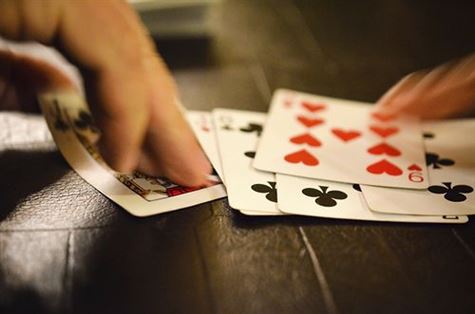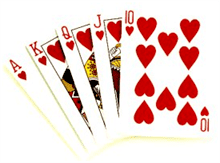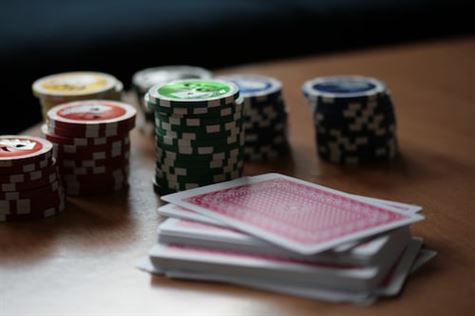Crunching Numbers in Poker: A Tactical Approach to Mathematics is a comprehensive guide that explores the role of mathematics in the game of poker. This book offers valuable insights into how understanding and applying mathematical concepts can greatly enhance a player’s strategic decision-making process. Whether you are a beginner looking to improve your game or an experienced player seeking to take your skills to the next level, this book provides a practical and tactical approach to using math in poker.
The Importance of Mathematics in Poker Strategy: Enhancing Your Gameplay
Poker is a game that combines skill, strategy, and chance. While luck plays a significant role in the outcome of each hand, it is the skillful use of strategy that separates the winners from the losers. One critical aspect of poker strategy is mathematics. Understanding the mathematical principles behind the game can greatly enhance your gameplay and give you an edge over your opponents.
Mathematics in poker is not about complicated equations or advanced calculus. It is about understanding the probabilities and odds associated with different hands and situations. By using basic math concepts, players can make more informed decisions at the table.
One fundamental concept in poker mathematics is pot odds. Pot odds refer to the ratio between the current size of the pot and the cost of a contemplated call. By comparing these two numbers, players can determine whether a particular bet or call is profitable in the long run. For example, if the pot contains $100 and the cost of a call is $20, the pot odds are 5:1. This means that for every $1 you invest, you stand to win $5. If the odds of winning the hand are higher than 5:1, it would be a profitable call.
Another important aspect of poker mathematics is expected value (EV). EV is a statistical measure that calculates the average amount a player can expect to win or lose on a particular decision over the long run. By considering both the potential winnings and the likelihood of success, players can determine which moves have positive expected value and should therefore be made.
To illustrate this concept, let’s say you are dealt a pair of pocket aces before the flop. The probability of winning with pocket aces against a random hand is approximately 85%. If there is $100 in the pot and your opponent bets $50, your expected value for calling would be calculated as follows: (0.85 * $150) – (0.15 * $50) = $127.50 – $7.50 = $120. In this scenario, calling the bet would have a positive expected value of $120.
Understanding poker mathematics also helps players with hand reading and range analysis. By considering the cards on the board, the actions of your opponents, and the probabilities associated with different hands, you can make more accurate predictions about what your opponents might be holding. This information allows you to adjust your own strategy accordingly and make better decisions throughout the game.
Moreover, mathematics can help in bluffing situations. By understanding the likelihood of certain hands being present based on the community cards and previous betting patterns, you can effectively bluff your opponents into folding stronger hands. This tactic is known as a semi-bluff and relies on calculating the probability of improving your hand if called.
In conclusion, mathematics plays a crucial role in developing a successful poker strategy. By understanding concepts such as pot odds, expected value, hand reading, and bluffing probabilities, players can make more informed decisions at the table. While luck will always be a factor in poker, a tactical approach to mathematics can give you a significant advantage over your opponents. So next time you sit down at the poker table, remember to crunch those numbers and play smart!
Calculating Pot Odds and Expected Value in Poker: Maximizing Profits
Poker is a game that combines skill, strategy, and a bit of luck. While some players rely solely on their instincts and intuition, others take a more tactical approach by using mathematics to gain an edge over their opponents. In this article, we will explore the importance of calculating pot odds and expected value in poker and how these concepts can help maximize profits.
Pot odds are a fundamental concept in poker that every player should be familiar with. They refer to the ratio of the current size of the pot to the cost of a contemplated call. By calculating pot odds, players can determine whether it is mathematically profitable to continue playing a hand.
To calculate pot odds, you need to compare the size of the bet you are facing to the size of the pot. Let’s say the pot contains $100, and your opponent bets $20. The pot odds would be 5:1 ($100/$20). This means that for every dollar you invest in the pot, you stand to win five dollars.
The next step is to compare the pot odds to your chances of winning the hand. This is where expected value comes into play. Expected value (EV) measures the average amount you can expect to win or lose in a specific situation over the long run.
To calculate EV, you multiply the probability of each possible outcome by its respective payoff and sum them up. For example, if there are two cards left to be dealt, and you have a flush draw, there are nine remaining cards of your suit in the deck. This gives you roughly a 19% chance of hitting your flush on the next card. If the pot odds are favorable, let’s say 3:1, then calling the bet would have a positive expected value.
By comparing the pot odds to the expected value, you can make informed decisions about whether to call, raise, or fold. If the pot odds are higher than the expected value, it is profitable to make the call. Conversely, if the pot odds are lower than the expected value, it is better to fold.
Calculating pot odds and expected value requires some mathematical skills, but it can significantly improve your overall profitability in poker. It allows you to make rational decisions based on objective data rather than relying solely on intuition or gut feelings.
However, it is important to note that pot odds and expected value are just one piece of the puzzle. They should be used in conjunction with other strategies and considerations such as reading your opponents, understanding table dynamics, and managing your bankroll.
In conclusion, crunching numbers in poker through calculating pot odds and expected value is a tactical approach that can help maximize profits. By understanding the relationship between the size of the pot and the cost of a contemplated call, players can determine whether it is mathematically advantageous to continue playing a hand. Additionally, by comparing pot odds to the expected value, players can make informed decisions about their next move. While mathematics alone cannot guarantee success in poker, it provides a solid foundation for making rational and profitable decisions at the table.
Understanding Probability and Statistics in Poker: Gaining the Upper Hand
In the world of poker, numbers hold a significant role. From calculating pot odds to understanding the probability of hitting certain hands, mathematics plays a crucial part in making informed decisions at the table. By delving into the realm of probability and statistics, players can gain a tactical advantage over their opponents.
One fundamental concept in poker is the notion of expected value (EV). EV represents the average outcome of a particular decision over the long run. It takes into account both the probability of each possible outcome and the potential payoff or loss associated with it. By considering the EV of different actions, players can make more rational choices that maximize their profitability.
To calculate EV, one must first determine the probability of each outcome. This involves assessing the number of favorable outcomes divided by the total number of possible outcomes. For example, if a player has four outs to hit a flush on the turn, they have approximately a 17% chance of completing their hand. By multiplying this probability by the potential profit gained from hitting the flush and subtracting the cost of continuing in the hand, one can estimate the EV of calling or folding.
Another essential aspect of poker mathematics is understanding pot odds. Pot odds refer to the ratio between the current size of the pot and the cost of a contemplated call. By comparing these two figures, players can determine whether calling a bet is profitable in the long run. If the pot odds are greater than the odds of completing a drawing hand, it is mathematically correct to make the call.
For instance, suppose there is $100 in the pot, and your opponent bets $20. If you have an open-ended straight draw with eight outs, your chances of hitting the winning card are around 31%. To calculate the pot odds, divide the amount you need to call ($20) by the total pot size after your call ($140). In this case, the pot odds are 1:7, meaning you only need to win the hand once in every eight attempts to break even. With a 31% chance of hitting your draw, calling would be profitable in the long run.
Understanding probability and statistics also allows players to make informed decisions regarding bluffing. By analyzing the likelihood of their opponents holding strong hands based on the community cards and previous betting patterns, players can strategically choose when to bluff. If the probability of an opponent having a strong hand is low, bluffing becomes a more viable option.
Moreover, statistical analysis helps players identify trends in their own gameplay and that of their opponents. By tracking data such as win rates, fold frequencies, and aggression levels, players can spot weaknesses in their strategies and exploit patterns in their opponents’ playstyles. This information provides valuable insights for adjusting one’s approach to maximize profitability.
In conclusion, mathematics plays a pivotal role in poker strategy. By understanding concepts such as expected value, pot odds, and probability, players can make calculated decisions that give them an edge over their opponents. The ability to crunch numbers and analyze statistics allows players to gain a deeper understanding of the game and make strategic choices that lead to long-term success at the poker table.
Applying Game Theory Concepts to Poker: Making Optimal Decisions
In the world of poker, success is often attributed to a combination of skill, strategy, and a little bit of luck. While many players rely on their intuition and experience to make decisions at the table, there is another approach that can significantly improve one’s chances of winning: applying game theory concepts.
Game theory is a mathematical framework used to analyze strategic interactions between different players or decision-makers. It provides a systematic way of approaching situations where the outcome depends not only on one’s own actions but also on the actions of others. By understanding and utilizing game theory principles, poker players can make more informed and optimal decisions.
One fundamental concept in game theory is the notion of equilibrium. In poker, an equilibrium represents a situation where each player’s strategy is optimal, given the strategies chosen by the other players. This means that no player can deviate from their strategy and expect to improve their overall outcome. By identifying and understanding equilibria in different poker scenarios, players can adjust their strategies accordingly to maximize their expected value.
Another important concept in game theory is the idea of mixed strategies. A mixed strategy involves choosing different actions with certain probabilities rather than always playing the same action. In poker, this means that players should not always follow predictable patterns or play hands in a completely deterministic manner. By introducing randomness into their decision-making process, players can keep their opponents guessing and prevent them from exploiting any perceived patterns.
Furthermore, game theory teaches us about the importance of balancing our ranges. In poker, a range refers to the set of possible hands that a player could have in a given situation. Balancing our ranges means that we should have a mix of strong and weak hands in our range, making it difficult for opponents to accurately deduce the strength of our hand based on our betting patterns. By carefully selecting which hands to include in our range and adjusting our betting accordingly, we can maintain a strategic advantage over our opponents.
Additionally, game theory helps us understand the concept of bluffing. Bluffing is an essential part of poker, as it allows players to win pots even with weaker hands by making their opponents fold. However, bluffing too often or at the wrong times can be costly. By applying game theory principles, players can determine the optimal frequency and timing for bluffing based on their opponent’s strategy and tendencies. This ensures that bluffing becomes a calculated risk rather than a random act.
In conclusion, applying game theory concepts to poker can greatly enhance a player’s decision-making process and overall success at the table. By understanding equilibria, utilizing mixed strategies, balancing ranges, and strategically bluffing, players can make more informed and optimal decisions. While intuition and experience still play a role in poker, incorporating mathematics and game theory into one’s approach can provide a tactical edge that sets them apart from their opponents. So next time you sit down at the poker table, remember to crunch the numbers and apply a strategic mindset – your winnings may just thank you.
Mastering Mathematical Concepts for Successful Bluffing in Poker
Poker is a game of skill, strategy, and calculated risks. While luck certainly plays a role in the outcome of each hand, it is the players who understand and utilize mathematical concepts that ultimately come out on top. In this article, we will explore how mastering mathematical concepts can improve your bluffing skills and give you an edge at the poker table.
One key mathematical concept that every successful poker player must grasp is probability. Understanding the likelihood of certain events occurring during a hand can greatly influence your decision-making process. For example, knowing the odds of hitting a flush or straight draw can help you determine whether to call or fold when facing a large bet. By calculating these probabilities accurately, you can make informed decisions that maximize your chances of success.
Another important mathematical concept in poker is expected value (EV). EV measures the potential profitability of a particular play over the long run. It takes into account both the probability of winning a hand and the amount of money at stake. By comparing the EV of different actions, such as betting, calling, or folding, you can identify the most profitable course of action. This allows you to make strategic bluffs that exploit your opponents’ tendencies and maximize your overall winnings.
Furthermore, understanding pot odds is crucial for successful bluffing in poker. Pot odds refer to the ratio between the current size of the pot and the cost of a contemplated call. By comparing the pot odds to the probability of completing a drawing hand, you can determine whether a bluff is likely to be profitable. If the pot odds are higher than the odds of completing your draw, it may be worth taking a calculated risk and bluffing to win the pot. However, if the pot odds are unfavorable, it is generally best to fold and wait for a better opportunity.
In addition to probability, EV, and pot odds, being able to calculate equity is another valuable skill for bluffing effectively. Equity represents the share of the pot that belongs to a player based on their chances of winning at any given moment. By accurately assessing your equity in a hand, you can determine whether it is advantageous to continue bluffing or if it is more prudent to abandon the bluff and cut your losses. Being able to calculate equity allows you to make well-informed decisions that maximize your chances of success.
Finally, understanding the concept of range balancing is essential for successful bluffing. Range balancing involves constructing a balanced set of hands that includes both strong holdings and bluffs. By maintaining a balanced range, you make it difficult for your opponents to accurately assess the strength of your hand. This increases the effectiveness of your bluffs as your opponents will be more likely to fold when facing aggression from a balanced range. Mastering range balancing requires a solid understanding of mathematical concepts and the ability to apply them strategically during gameplay.
In conclusion, mastering mathematical concepts is crucial for successful bluffing in poker. Probability, EV, pot odds, equity, and range balancing are all key elements that can give you an edge at the poker table. By understanding these concepts and using them strategically, you can improve your decision-making process, exploit your opponents’ tendencies, and increase your overall profitability. So next time you sit down at the poker table, remember to crunch the numbers and approach the game with a tactical mindset.




